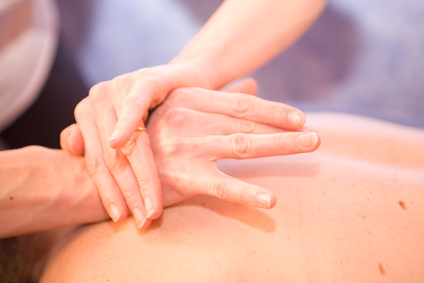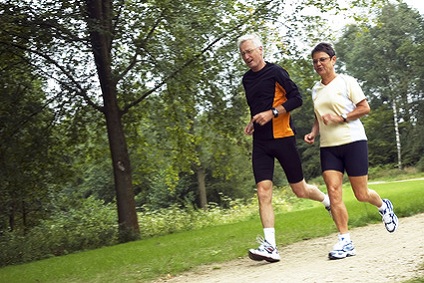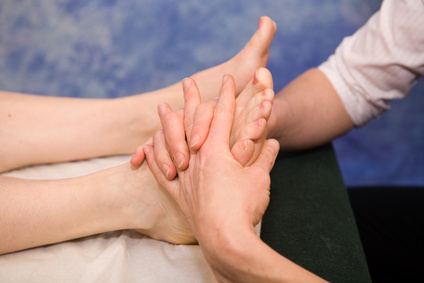
Back Pain Facts
- Back pain will affect 80% of us at some point in our lives and half of people who experience an episode of back pain will have another episode within 2 years.
- Back pain is the 3rd most common reason to visit your GP and costs the economy millions each year.
- Even a minor back sprain can be very painful and alarming.
However, the good news is:
- Chiropractic treatment can help.
- Evidence supports the use of Chiropractic treatment for acute (sudden onset) and chronic (long-term) back pain.
- There are lots of things you can do to help yourself.
- Most back pain improves within days.
- The vast major of back pain is not due to serious disease.
- Very few back problems ever need surgery
What Causes Back Pain?
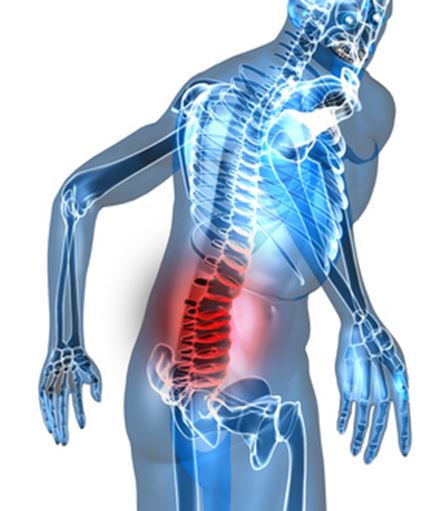
Back pain is a very complex issue. Back pain often comes on for no apparent reason, performing a movement we have done thousands of times before e.g. doing up your shoe lace, bending to pick a pen off the floor or even just sneezing!
Obviously, these actions themselves do not cause the problem or pain would occur every time we performed that activity. Back pain is usually an accumulation of stresses over a long period of time rather than one specific event.
There are many factors that influence back pain. Many of these problems are down to our modern lifestyles, which involve too much sitting, not enough exercise, high levels of stress and poor diets.
Risk factors for developing back pain include:
- Poor posture and muscle weakness/tightness
- Prolonged sitting
- Poor fitness levels
- Overuse - too much of one particular activity e.g. athletes and manual workers
- Being overweight
- Congenital problems e.g. scoliosis
- Accidents e.g. road traffic accidents
Advice for Acute Back Pain
Use an ice pack
Ice will help bring down the inflammation and swelling in the injured area. Do not use heat for the 1st 24-48 hours as this could make the problem worse. You can use an ice pack or a bag of frozen peas. Make sure you cover the ice pack in
a tea towel or kitchen paper, to avoid burning the skin. Use the ice for 20-30 minutes, every 2 hours or as often as possible.
Keep mobile
Do not stay in one position, e.g. sitting, driving, standing, too long as it will cause the back to stiffen further. Gently walking is recommended. If you cannot tolerate walking, try crawling on all fours until you loosen up.
Avoid prolonged bed rest
Bed rest is not a recommended treatment. Staying in bed for more than 1-2 days has been shown to prolong the pain, increase stiffness and reduce muscle strength. This makes it harder to get going again and increases the likelihood of chronic
or recurring pain.
Sitting posture
Avoid sofas and deep chairs. Sit in higher chairs e.g. dining room chair. If the chair does not have a good low back support, place a small cushion or rolled up towel in the small of your back. This helps keep the natural arch in your spine.
Listen to your back
Pain is a warning sign, don't ignore it. If what you are doing hurts - STOP. Don't try to push through the pain.
Rest as comfortably as you can
Most people find lying with their knees bent, either on your side or back, most comfortable. This relieves pressure on the spine and helps the muscles relax.
Medication
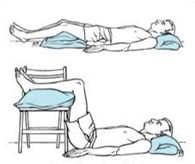
Ask your Chiropractor/Doctor/Pharmacist what the best medication would be to take.
Accept help
Let your friends and family help you with day to day activities such as housework, DIY and gardening. If you push yourself to hard the injury will take longer to heal.
Back Pain Prevention
Keep active
Regular exercise helps keep the back strong and flexible. Choose an activity you enjoy or you won't keep it up. Pick something that is right for you fittest level and increase the intensity gradually.
Choose the right mattress
For most people a medium, pocket sprung mattress is best, as it spreads your weight more evenly. If the mattress is too hard it puts increased stress on shoulders and hips; too soft and it will sag it to middle. Many people also find memory
foam mattresses very comfortable. It is also worth being aware the word "orthopaedic" means nothing when applied to beds.
Don't sleep on your stomach
This increases the stress on your low back and neck joints.
Bend from the waist keeping your back straight
Don't stoop and twist. This is the most common cause of back injuries even without lifting anything!
Don't sit for too long
Prolonged sitting causes increase load on the spinal discs and weakens the muscles. Aim to get up and move about every 30-40 minutes.
Computer advice
Most people spend a considerable amount of time using a computer, which can put our back under strain and can make us vulnerable to injury. Here is some advice to minimise the effects of using your computer.
Seat Position
Hips should be slightly higher than your knees. Feet should be flat on the floor. Sit with your bottom at the back of the chair with your shoulder blades against the back rest
Low Back Support
Choose a chair with a lumbar support or place a small cushion in the small of your back. This will arch the lower back slightly, to maintain its proper alignment and reduce pressure on the spine.
Eye level
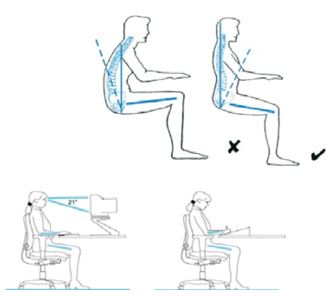
Your gaze should be aimed at the top of the screen. Adjust the height of the monitor using a stand or even book. Just make sure its stable.
Arm position
Arms should be flat and your elbows level with the desk. Use a chair with arm rests.
Laptop advice
Laptops are very convenient for working on the move but can make it tempting to work in awkward positions. To reduce the risk of injury, follow this advice.
- Invest in a laptop stand, to ensure the screen is at eye level.
- Buy a separate keyboard and mouse you can plug in when using your laptop at home.
- Use a rucksack design laptop case and carry it on both shoulders.
Driving advice
Seat Height
Knees should be level or slightly below your hips, this maintains the nature curve in your spine.
Seat Angle
Your seat should be 10 degrees back from the upright position, to reduce pressure on the base of the spine.
Lumbar Support
If your car does not have a lumbar support, place a small rolled up towel in the small of your back to keep the natural curve.
Steering Wheel Position
Once you have adjusted your seat correctly, your hands should fall naturally on the steering wheel, with just a slight bend in the arms.
Take Regular Breaks
Aim to stop 1-2 hours, get out of the car and move around for 5-10 minutes.
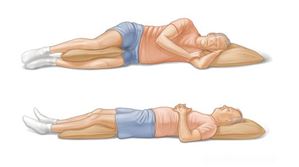
Sleeping advice
- The ideal position for sleep is on your side with your knees bent with a pillow between them. This helps maintain spinal alignment, thus reducing stress on the spine.
- If you sleep on your back place a pillow under knees to reduce strain on your lower back.
- Do not sleep on your front as this puts excessive stress on the neck and low back, which can lead to recurring pain.
